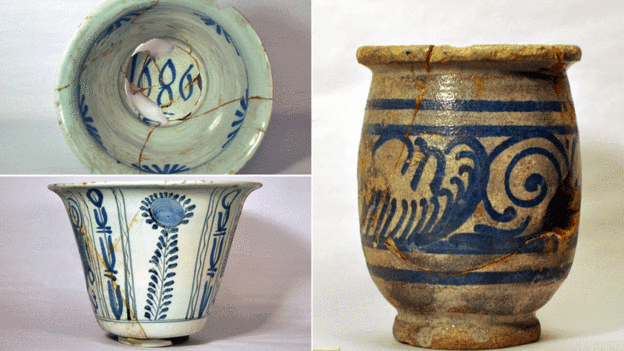
A medicinal jar and bowl were also found in the latrine. [PHOTO: bbc.com]
Archaeologist Jette Linaa, from the Moesgaard Museum in Aarhus, Denmark, was investigating the emigration of people from the rural countryside to Danish cities during the 15th-17th centuries with her colleague Christian Vraengmose. While looking for some information, they uncovered a box in the storage archives of the museum. Inside, there was a broken bottle with some…odd contents: a 300-year-old poo.
It might not seem like much, but feces can actually tell historians quite a lot of valuable information. It can be carbon dated, and can give insight into what the person it belonged to was eating at the time, and how healthy they were. From that, historians and researchers can determine how rich the person was, and even where they lived. That’s exactly what they did.
“Our archaeobotanist analysed it and found various seeds, nuts and berries,” Jette Linaa said. Specifically, the analysis revealed the person had eaten figs, grapes, pepper, and buckwheat.
Thanks to the other artifacts in the box, including a jar, a bowl, and a glass flask that were made in the Dutch city of Delft, the researchers were able to look back in the museum catalogues to see where these artifacts had been recovered from.
Apparently, the artifacts, including the poo, came from an archaeological dig conducted in 1937 at a 17th-century manor, belonging to the Bishop of the Danish city of Aalborg. His name was Bishop Jens Bircherod.
“It all fits nicely with the bishop who lived in that house from 1694 to 1708.” Jette Linaa explained. “He had a typical upper-class diet, he was part of the upper class.”
The people of Aalborg commonly ate gruel, cabbage, pork, and buckwheat. The figs and pepper were the clues that pointed to the bishop. Items like that were expensive and rare, so the person who ate them had to be from the upper crust of society.
For now, work on the Bishop’s manor has started again. The archaeologists are hoping to discover who lived there.
“We know, of course it was the bishop, his wife and his children, and then a few servants, but not at this point how many.” – Jette Linaa

